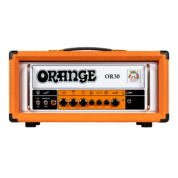昨年のHøstsabbatフェスティバルで、GraveyardのベーシストTruls Mörckをノルウェーの教会の外でインタビューしました。 現在、今年のDesertfest Londonの準備中で、金曜日にはElectric Ballroomでヘッドライナーを務める予定です。 そこでお会いできるでしょうか? チケットはこちら
“One of the biggest things that you learn from 50-odd years of experience,” begins Cliff Cooper, founder and CEO of Orange Amps, “is the ability to listen to something and just say no to a sound—and to keep saying no until you can truthfully say yes.” Although that seems, on the face of it, like a fairly simple requirement, Cooper, who started Orange Amps in 1968 with modest means and an exacting personality, is only too aware of the pratfalls of such pickiness: “But the problem with saying no to a sound or a product is that it costs time and money”, he explains. “Each time, you’ve got to work out why you’re saying no, and go back to the drawing board to fix it—and that’s the difficult part.”
That iterative loop—of listening and tweaking, pouring over schematics and components, then listening again, each time getting slightly closer to that resounding “yes”—has been a pattern played out throughout Orange’s history, and is perhaps the cornerstone of its success, with musicians returning again and again for the past five decades, knowing they’re going to get a piece of equipment that sounds perfect and is built to last.
Today, however, for the first time in the company’s history, Cooper is explaining that development process not in the context of a new guitar amp or effects pedal, but of a product built for both musicians and non-musicians alike: a premium Bluetooth wireless speaker called the Orange Box, which is also an Orange first—specifically, the first consumer-facing product designed entirely in house by Orange’s engineering wizards, from the ground up.
Since the initial blueprints were drawn up back in 2017, Cooper and the team have said “no” to a lot of Orange Box sounds. Now, however, they’ve given it a yes, and the Orange Box is available from tomorrow, starting a new chapter in the history of Orange Amps. Accordingly, this is a story of how over half a century of guitar-amp expertise can be adapted to something more universal; a story of trial, error, patience and success; and a story of what Cooper describes as one of the most important products Orange has ever made.
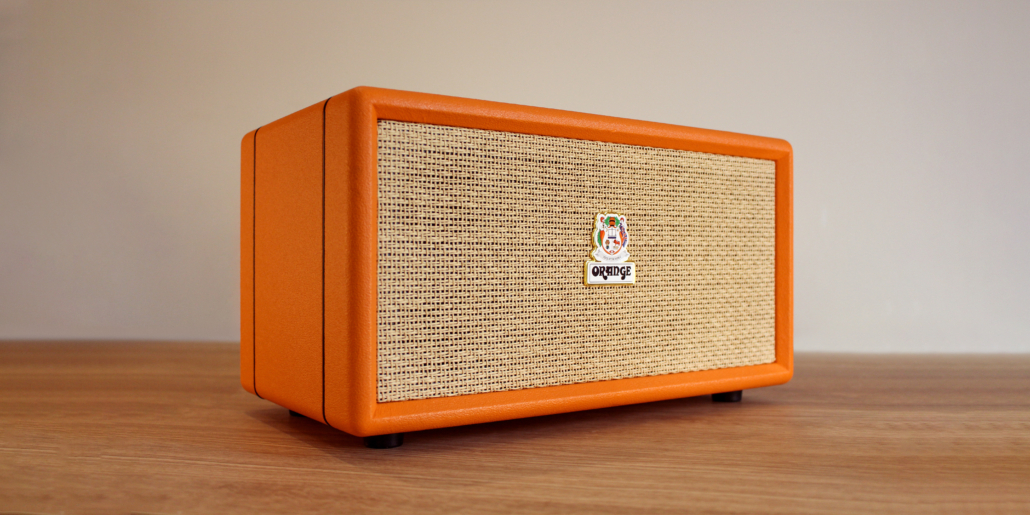
“When we had the first prototype back for testing,” recalls Cooper of the early days of Orange Box development, “it just wasn’t better than anything else. It was fine—good, even—but it just didn’t stand out, and one of the things Orange has always been proud of is that anything we do has to be better than what’s already out there.
“So that’s why it took so long,” he continues, with a wry smile, knowing not only how six years stretches out in the world of research and development, but also knowing now that the Orange Box really does stand out. And it was clearly time well spent: listening to that initial prototype—then nicknamed the Juicebox—at Orange’s development laboratory is simultaneously a revelatory and lacklustre experience, with all three test songs of various genres selected for this article to put the unit through its paces sounding tepid and distant. Only Madonna’s ‘Hung Up’ has the faintest flicker of life (Bowie’s ‘Modern Love’ and Led Zep’s ‘Black Dog’ are pale imitations of their true selves), but the reality is that this particular Juicebox contained a far-too-diluted, watery recipe.
The second and third versions fared slightly better. For these, the R&D team experimented with weight-saving neodymium speakers and a more lozenge-shaped form-factor, and as a result, all three songs started to resemble their imperious selves. There was still something off, though—a sort of drab fizziness, like day-old soda water, with strangely scooped mids and muffled bass.
Thankfully, the fix was at hand: “After several prototypes,” explains Cooper, “we decided that the only way to improve the sound was to use active electronic crossovers, which other companies weren’t doing.”
The active crossover in a unit like the Orange Box splits the incoming audio signal in two based on frequency range, with the different signals being sent to different amplifiers specific to those ranges, and then on to appropriate speakers custom-tuned to those frequencies. An active crossover has the advantage of perfectly matching the respective specialist amplifiers and speakers, making sure all parts of the path work together holistically, and each part of the sound is dealt with by the most appropriate equipment. An active crossover also prevents loss of information in the splitting process, meaning that all the audio in your favourite records is retained, all the way to the speakers’ cones.
Getting that split-point right, however, is always the key, and this is where the expertise that Orange technical director Adrian Emsley, amp-design genius and brains behind virtually every Orange product for the past 25 years, shone through: “Frank and I changed the crossover so that just the amp dealing with the bottom end was Class D,” explains Emsley of his work on the Orange Box, alongside colleague and Cambridge academic Frank Cooke of JPF Amplification. “Then, the two amps dealing with the midrange and treble, on the left and right, were Class AB, which ends up much more musical in the area it needs to be.”
And musicality is exactly the watchword here. Listening again to those same songs on the first Orange Box prototype to implement such a crossover is a lightbulb moment, like a jump from black and white to colour: suddenly, Bowie’s vocals carry genuine anguish and Jimmy Page’s guitar a tangible bite. The arpeggiating synths on ‘Hung Up’, too, sound almost three-dimensional.
“Unlike a different guitar amp company’s wireless speaker, which is only stereo above around 3 or 4 kHz,” continues Emsley, referring to a frequency range in the very highest octave of a concert piano, “our version is stereo above 300 Hz [the middle of the piano], which works especially well with AC/DC-style guitar music, where Angus is on the left and Malcolm is on the right.
“Those other wireless speakers all sound pretty bad with AC/DC,” adds Emsley, ever the rock purist, “which I think is a very poor result.”
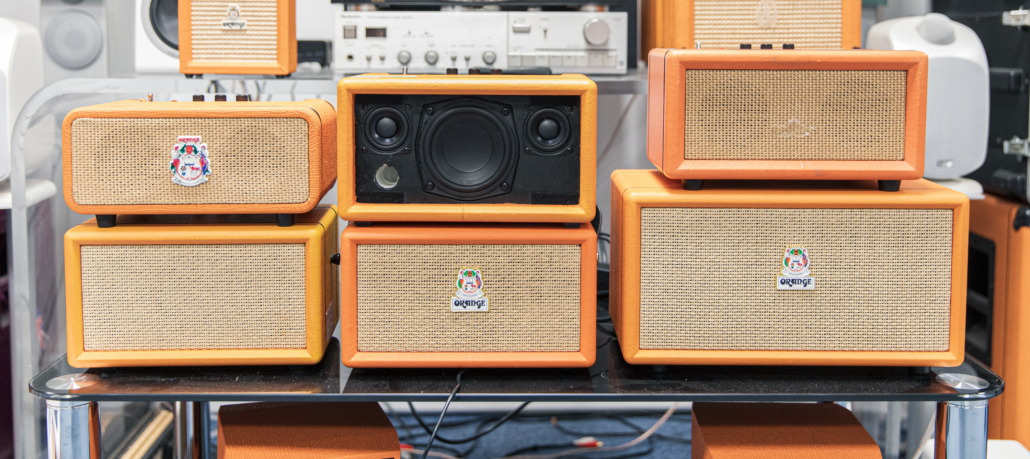
“The other thing, of course,” continues Cooper, “is that we use a wooden box. We could have used a plastic cabinet, to make it a bit more cost-effective, but it just sounded dreadful. Putting the speakers inside a wooden cabinet sounds much better, and we spent a lot of time making sure that the actual wood resonates correctly given the internal volume. If the cabinet resonates at the wrong frequencies, it just doesn’t sound right, you know.”
This level of perfectionism is evident upon examining the works-in-progress: each rejected test model had a different shape and heft, some including holes covered with rubber plugs, others with curved sides. Myriad porting options were clearly investigated, auditioned and tweaked. Every possibility was covered, it appears, before landing on the finished design. Then, finally, Emsley hit on the idea of making the crossover itself interact with its surroundings: “I put a hole in the active crossover at the frequency of the enclosure,” he reveals. “This ‘de-boxed’ the box, if you like, and gave the whole thing a more balanced frequency response.”
The result? Genuinely a sonically startling piece of kit, delivering the sort of audio quality you’d normally hear from speakers five times the size and price. All three test songs now leapt from the speakers, but not in the obnoxious, attention-grabbing way that has become the hallmark of a lot of more artless Bluetooth speakers, all booming bass and fool’s-gold glittery highs. Instead, the rasp of the sax lines on ‘Modern Love’ became almost tangible, and the undulations and throbs on ‘Hung Up’ were subtle and seductive, just as you’d imagine the producers of those records intended. ‘Black Dog’ growled with all the the verve and thrust as the first time you heard it.
In short, it made you want to play these songs again and again, and this repeat playability—that potential for long-term listening—has become an obsession of Cooper’s over the years: “One thing we kept an ear out for when testing was controlling for ‘listening fatigue’, which is when you listen through a product for a long time, and after a while it just doesn’t sound nice,” he explains. Any music lover will recognise the condition, and although exact causes of listener fatigue are still being explored, the latest research suggests that imperceptible sonic artefacts arising from non-musical aspects of a song’s reproduction, such as compression or artificial spatialisation, can cause listeners to lose interest.
“It’s difficult to design an amplifier or a speaker to control for listening fatigue specifically, because there are so many factors to take into account,” confesses Cooper, “but with the Orange Box you really can play it for ages—I have done!—and it doesn’t grate on your ears to the point where you think, I need to turn that thing off.”
A level of product testing this meticulous and drawn out, coupled with a love of making something that’s built to last, feels a long way from other bigger manufacturers’ approaches, which so often involves buying an off-the-shelf design from a Chinese third party, slapping their badge on it and releasing it without a second thought. But Cooper wouldn’t have it any other way: “It’s important that anything we bring out is fully researched by us and at the top of its range, and I think everybody in the company accepts that—Adrian in particular is fussy about everything!” he laughs of his colleague for nearly half of Orange’s entire existence. “It not only has to be really good, but it has to be bulletproof, and everything has to be built to last in terms of the components.”
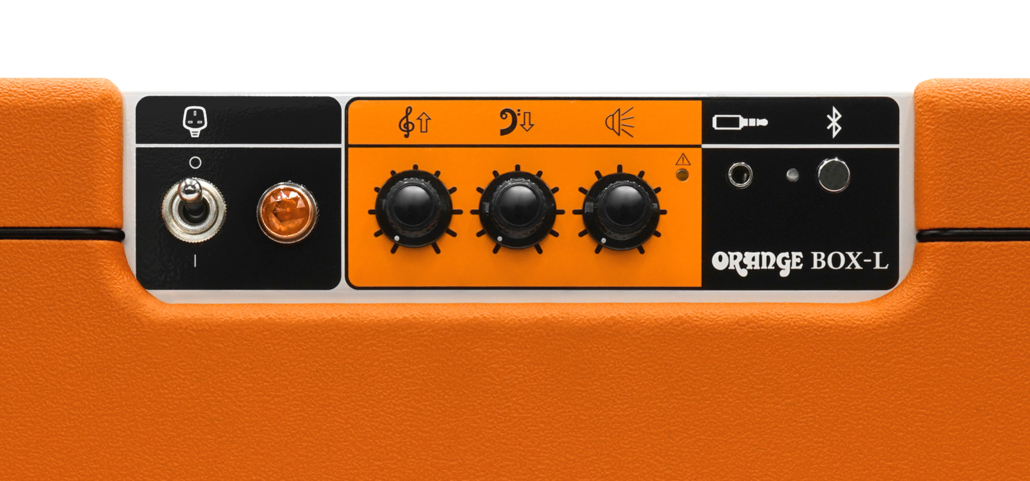
Indeed, product longevity is another characteristic that Cooper and the team have carried from guitar-amp manufacturing over to the Orange Box: in a Bluetooth speaker marketplace saturated with disposable gadgets destined for landfill before the end of the summer festival season, Cooper was insistent that the Orange Box had to have premium staying power. That means the rechargeable battery had to be replaceable, and all components be made available for replacement well into the next decade, therefore also ensuring that the box was as green as it was Orange.
On top of that, the Orange Box comes with a unique audio-safety feature designed to lengthen the lifespan of the product: a tiny circuit between the crossover and the amps continuously monitors the volume of the signal going in, prompting a small LED to light up whenever the speakers are being driven too hard and potentially harming them. “It’s there to tell you when you should back off the volume so you don’t damage it, sure,” acknowledges Cooper, “but it’s also there to improve sound quality, to help you listen without any distortion, which in turn lessens listener fatigue.”
This audio-limiter light is a simple innovation that will keep the Orange Box in its prime for years, but it’s also a dead giveaway of a product designed not with the bottom line in mind, but with a genuine and enduring love for music, and for building innovative tools for spreading that love. After all, no one would ask for such an attentive add-on, but plenty will be grateful once it’s there.
It’s a feeling that sums up Cooper’s attitude, too: “Within the company,” he explains, “there’s an old-fashioned need to do things properly that’s run for 50 years, and if we can put it over to consumers that when they buy something with the Orange brand on it, it’s going to sound good, then that’s an achievement, and I think the Orange Box can do exactly that.
“After all, we don’t have any shareholders or venture capitalists to answer to,” he continues, proudly. “I’m the only shareholder! so any money that we earn goes straight back into developing new products—and I love doing that.”
It’s an approach that’s stood Cooper, and Orange Amps, in excellent stead since the 1960s, with countless iconic guitar amps—and world-famous fans—to show for it. As the company branches out into the middle of the 21st century, and to music connoisseurs, players and non-players alike, it’s also an approach, you sense, that will future-proof it too. ▣
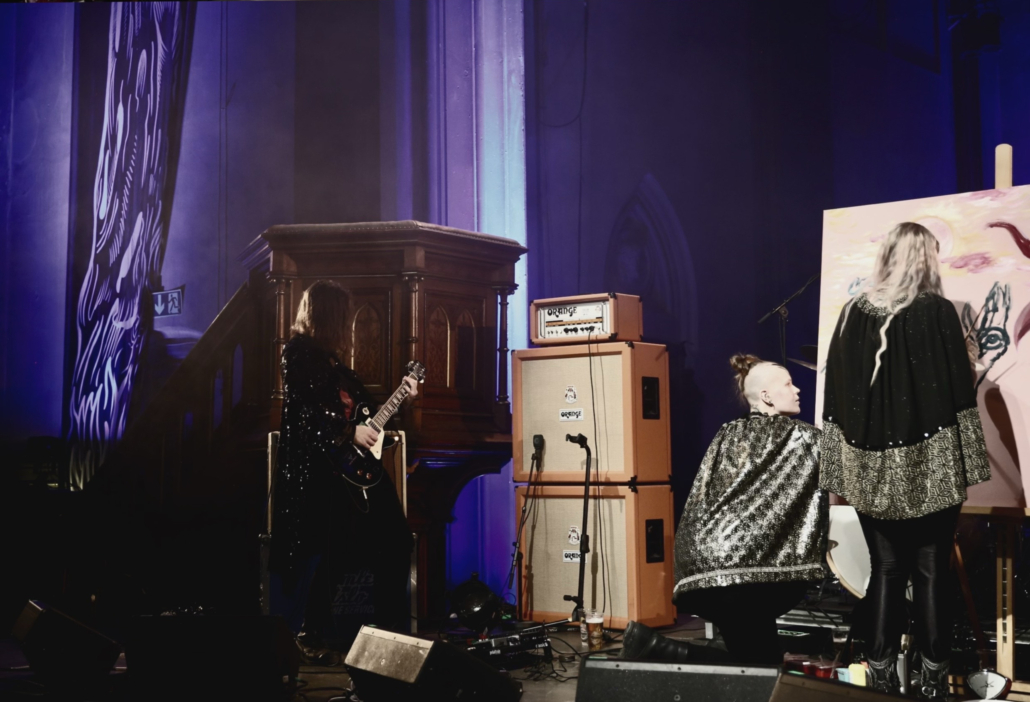
名前 トライン・グリム
職業と仕事場 オスロのLucky 7のタトゥーアーティスト、アーティスト
タトゥーを始めたのは何歳のときですか?
オスロに引っ越してきてタトゥーを始めたのは19歳になったばかりの頃でしたが、タトゥーに興味を持ったのはもっと前のことです。
男性が非常に多い業界で成功した女性として、性別に基づく課題に直面したり、ハラスメントを経験したり、その他の問題を抱えたりしたことはありますか?
これは難しい話題ですが、他の男性優位の職業と同様に、女性であることの葛藤があるでしょう。 私は現場に入ったとき、とても若かったので、それだけで自分を証明しなければならないことがよくありましたね。 同僚や上司、そしてお客さんからも、いつも名前を呼ばれていました。 一番大変だったのは、尊敬する人を信じることだと思います。 当時はとても小さなシーンだったので、発言するのがいつも怖かったんです。 この15年間で、確実に変化しました。才能ある女性たちがシーンに登場し、ゲームで絶対的な成功を収めているのを見るのは嬉しいことです。 そのため、今でもお客さんから「社長はいるのか」「いつから刺青をやっているのか」と聞かれることがあります。 きっと、33歳の男性に同じ質問をすることはないでしょう。 でも、メタル音楽とスノーボードとスケートボードが主な趣味だったんだ。 みんなとつるんでシーンに参加していたんですが、なかなか対等に扱ってもらえなかったんでしょうね。 音楽シーンにいるというだけで、何度グルーピーと呼ばれたことか、今でもあることです。
タトゥーの他にも、ギグポスターやアートワーク、DJなどもされていますが、どのような音楽がお好きですか?
タトゥーに時間を取られるのは、単純に好きだからです。 スノーボードを除けば、私の人生において唯一不変のものであり、他のプロジェクトを行うためにタトゥーを減らそうとしても、フルタイムで戻ってくるのです。 バンドの小さなプロジェクトも引き受けていて、主にギグポスターやシャツのデザイン、フェスティバルのポスターなど、時間はかかりますが、音楽はとても身近なものなので、もっとやってみたいと思っています。 自分の好きなバンドに自分のアートワークが使われているのを見るのは、何にも代えがたい喜びです。 ピアニストだった祖母の影響で、クラシック音楽で育ちました。 母の影響でレッド・ツェッペリンやジミ・ヘンドリックスのようなロックに親しんだが、ノルウェー西海岸出身の僕と親友がブラックメタル・シーンにのめり込むまでに、そう時間はかからなかった。 私の音楽の趣味は、ジャズからエクストリームメタルまで、今、あらゆるところにありますが、ヘビーリフは私のプレイリストのメイントピックとなっています。 DJは楽しいけど、特別なイベントじゃないとダメなんです。 バーで音楽を演奏するのは、ビールを買ってもらうためだけで、もう私には無理です。 家でレコードを聴く方がいい。 ははは…でも、楽しいし、いつか気が変わってまたやり直すかもしれませんね。
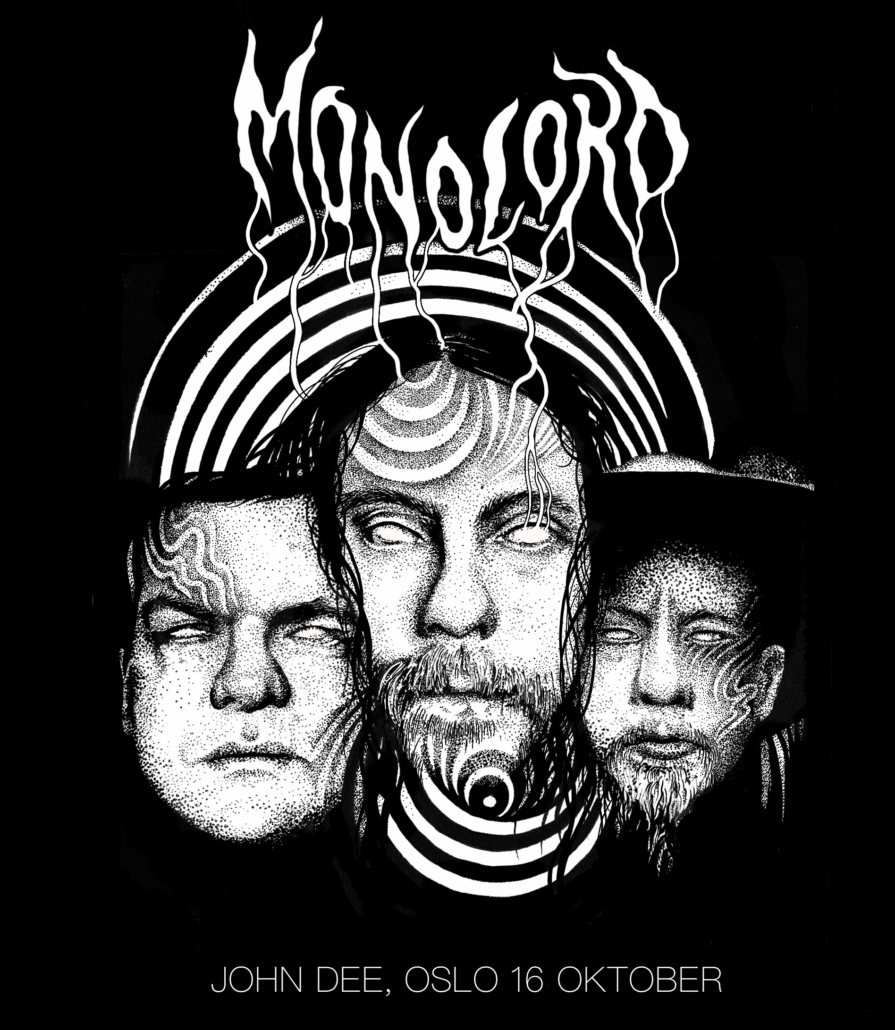
あなたの音楽の趣味は、あなたのアートにインスピレーションを与えていると言えるでしょうか?
音楽は私の芸術の主なインスピレーション源です。芸術と音楽は密接に関係していると思います。 音楽を聴きながら、ただひたすら絵を描くのが好きです。 また、タトゥーをしている間は一日中音楽を聴いています。 これがないと頭が忙しすぎるんです。 ある種の瞑想のようなものだと思います。 私の宇宙飛行士の絵は、スリープが2018年に『ザ・サイエンス』を出したときに作ったものがほとんどで、テーマが合っているんでしょうね。 ははは…。
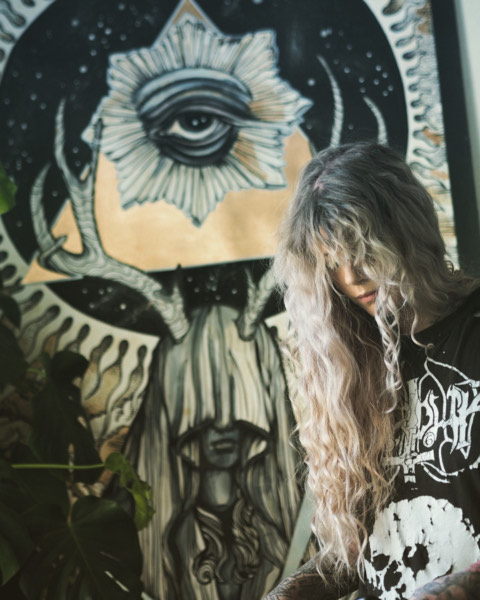
このインタビューについてトリーネに尋ねたところ、彼女はファンアートを作成できないかと尋ね、以下のような素晴らしいデザインを送ってくれました。
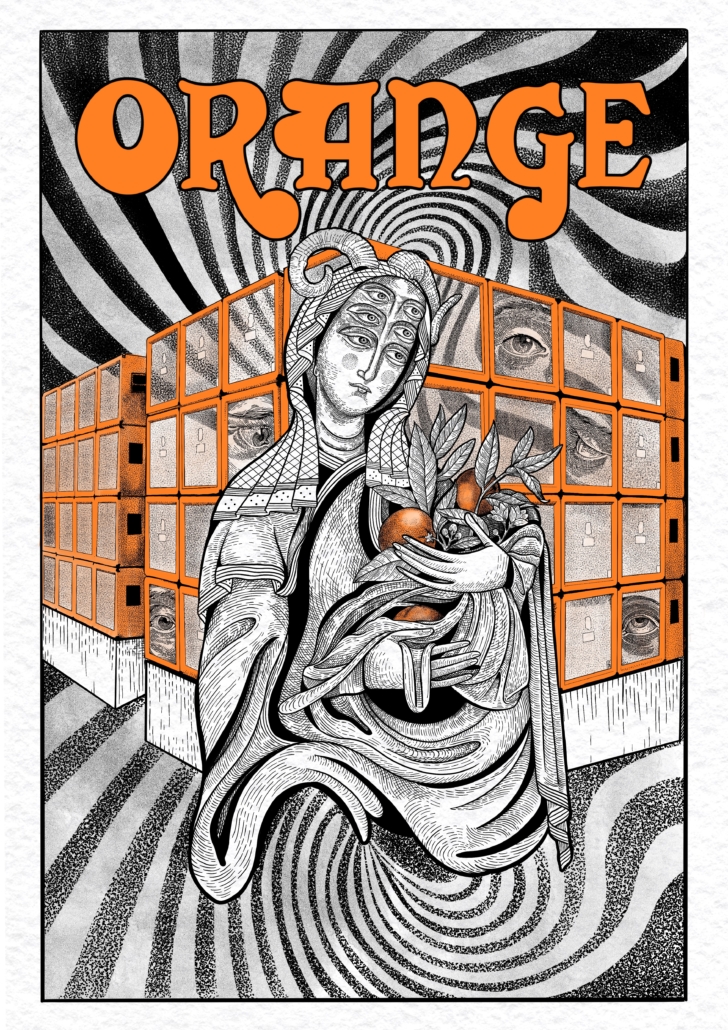
Orangeすごい絵を描いたのは、どんな思いからですか?
ヘビーミュージックに傾倒している人なら、オレンジ色のアンプのクラシックな姿に勝るものはないでしょう。 私は友人たちと、新しいバンドを見るときは、ステージにOrangeいたらいいバンドだと思う、という冗談を言っていました。 クラシックなロゴからインスピレーションを得たのは、その背景にあるストーリーがとても気に入ったからです。 枝としてのオレンジの木、パンをイメージした角。 後ろの運命のリグは、考えてみるとなんとなくそう見えるんですよね。 時々、思いついたことをそのまま描くことがありますが、大抵は意味を成さないものです。 そんなところからインスピレーションを受けたんでしょうね。
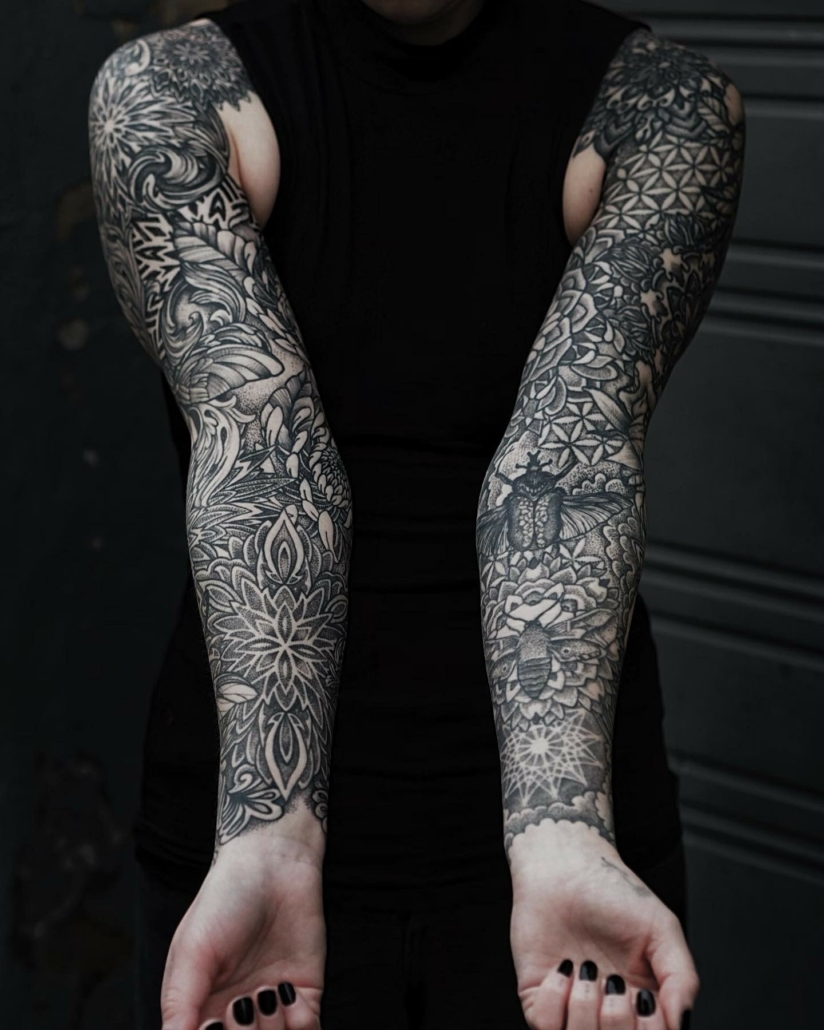
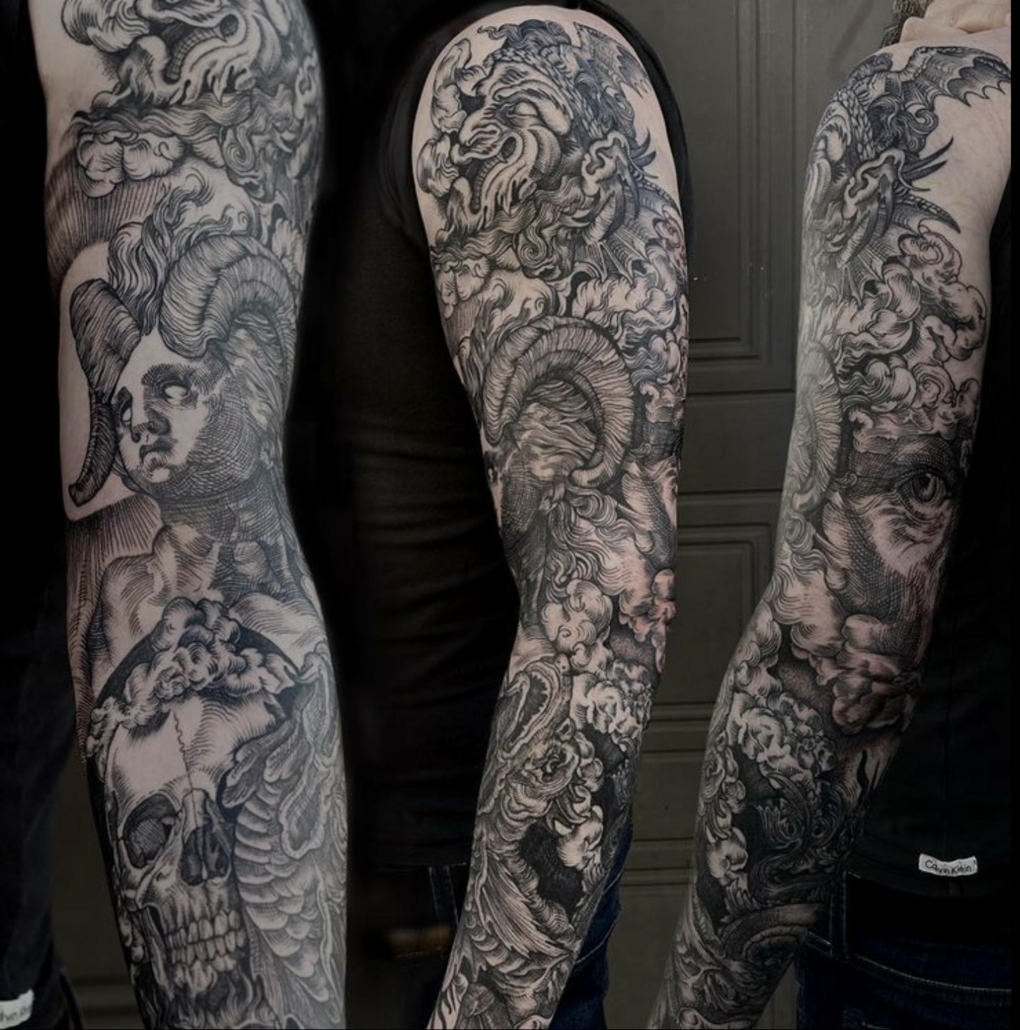
これまでのキャリアのハイライトは何だったのでしょうか?
それは難しい質問ですね。 仕事柄、たくさんの素晴らしい人たちに出会います。 レミーに会って、彼とつるんでタトゥーの話をしたのも間違いなく楽しい思い出のひとつですが、直接的に影響を受けたことをひとつ挙げるとすれば、NASAのエンジニアに宇宙飛行士の絵を売ったことは大きなハイライトだったと思います。 私は昔から科学に関してはオタクで、子供の頃は宇宙物理学者になりたかったんです。 少なくとも私は今、NASAと何らかのつながりがあるのだと思います。
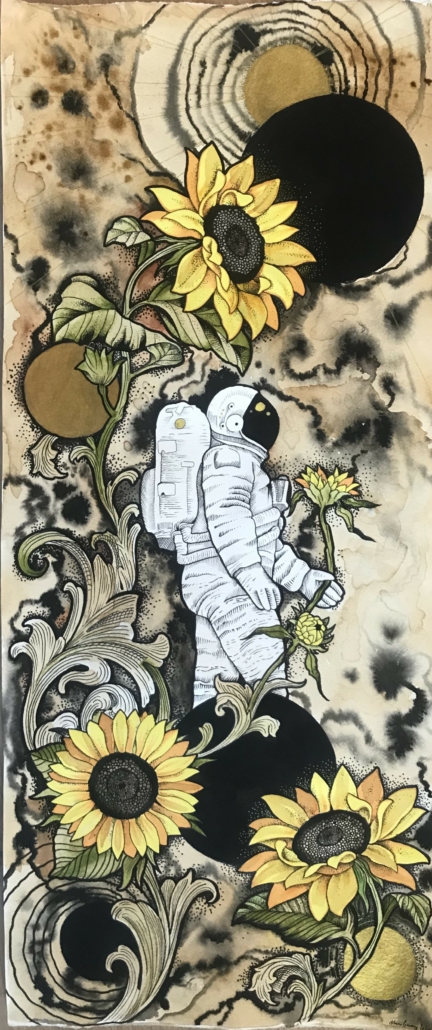
2023年のトラインは、2013年のトラインに何を言うのでしょうか?
2013年に初めて個展を開いたのですが、とても怖くて、何をやっているのか全く分かりませんでした。 私だったら、「もっと楽になるし、10年後も自分のやっていることが好きでいられるよ」と言ったと思います。 なぜなら、辛い日もあれば、目が覚めたときになぜ自分が休むことのできない仕事を選んだのかわからなくなる日もあるからです。
現在、リピート再生しているアーティスト/楽曲は?
最近すごく懐かしいので、Pentagram(U.S.)はリピートしています。 でも、スタジオでは毎日60年代と70年代だけのプレイリストがループしているんです。 クラシックに間違いはない。
国際女性デーと女性月間を記念して、男性優位の業界でキャリアを築くためのお話を、業界の女性プロフェッショナルに伺いました。 最初に登場するのは、音楽ジャーナリストで作家のリズ・スカーレットさん。
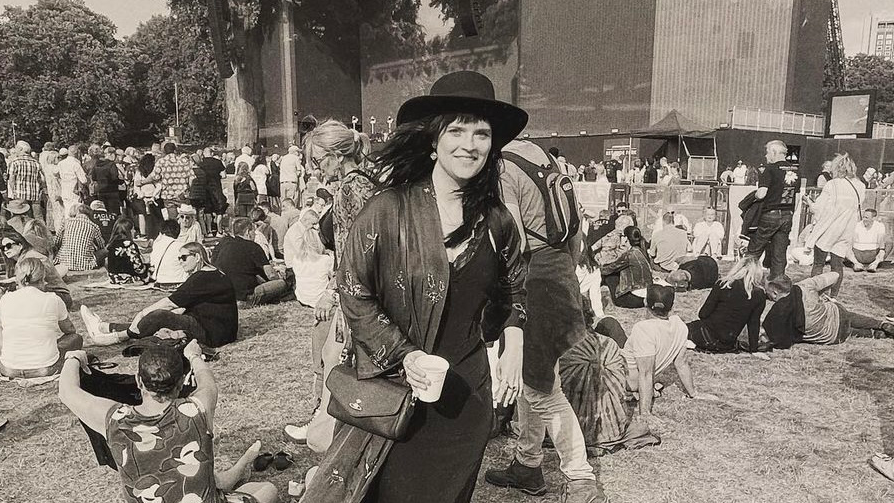
名前 リズ・スカーレット
職業と勤務先 クラシックロック、メタルハマー、プログレマガジンの本拠地であるLouderを持つFuture Publishingのスタッフライター(音楽ジャーナリスト)。
現在の職務に就いてから何年になりますか? 2年余り。
今日に至るまでの道のりについて教えてください。
だから、大学では音楽ジャーナリズムを学びましたが、その学位は実は第一志望ではなかったんです。 そんなコースがあるなんて知らなかった。単純に英語が得意だとわかったから、何を勉強したいのかわからないから英語をやろうと思っていたのに、大学の面接で、ずっと好きなバンドやジャーナリズムへの愛について教授と話すことになったんだ。 そして、そのようなコースがあることを教えてもらい、数年の教育期間を経て、私は音楽大学のマーケティング・アシスタントの仕事に就き、学生の作品をレビューしたり、多くのクリエイティブなプロジェクトを手伝ったり、自分の音楽ブログを運営しながら、卒業しました。
その後、パンデミックの時に、フューチャーパブリッシングがトレーニー役を募集していました。 Louderや自分が育った雑誌がある会社だということをすっかり忘れていて、前職を余剰人員にされたこともあり、気まぐれに応募してみました。 面接を受けた後、私は偶然にも自分の夢であるメタルハマーとクラシックロックの仕事に応募していたことに気づきましたが、これはちょっと不気味で…そして本当にクレイジーです。 マニフェステーションとか!? ニュースライターとして働くために、NCTJ diploma with Futureの勉強をし、メディア法の勉強を何時間もした後、フルタイムのスタッフライターとしてLouderで働くことになりました。 現在もニュース業務が中心ですが、オンラインや印刷物で、特集やインタビューも担当しています。
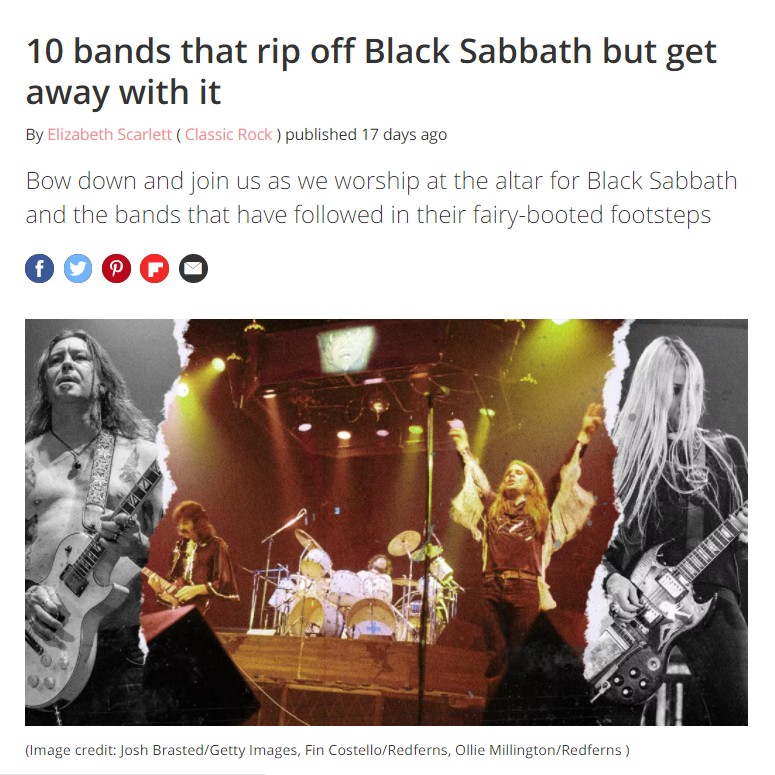
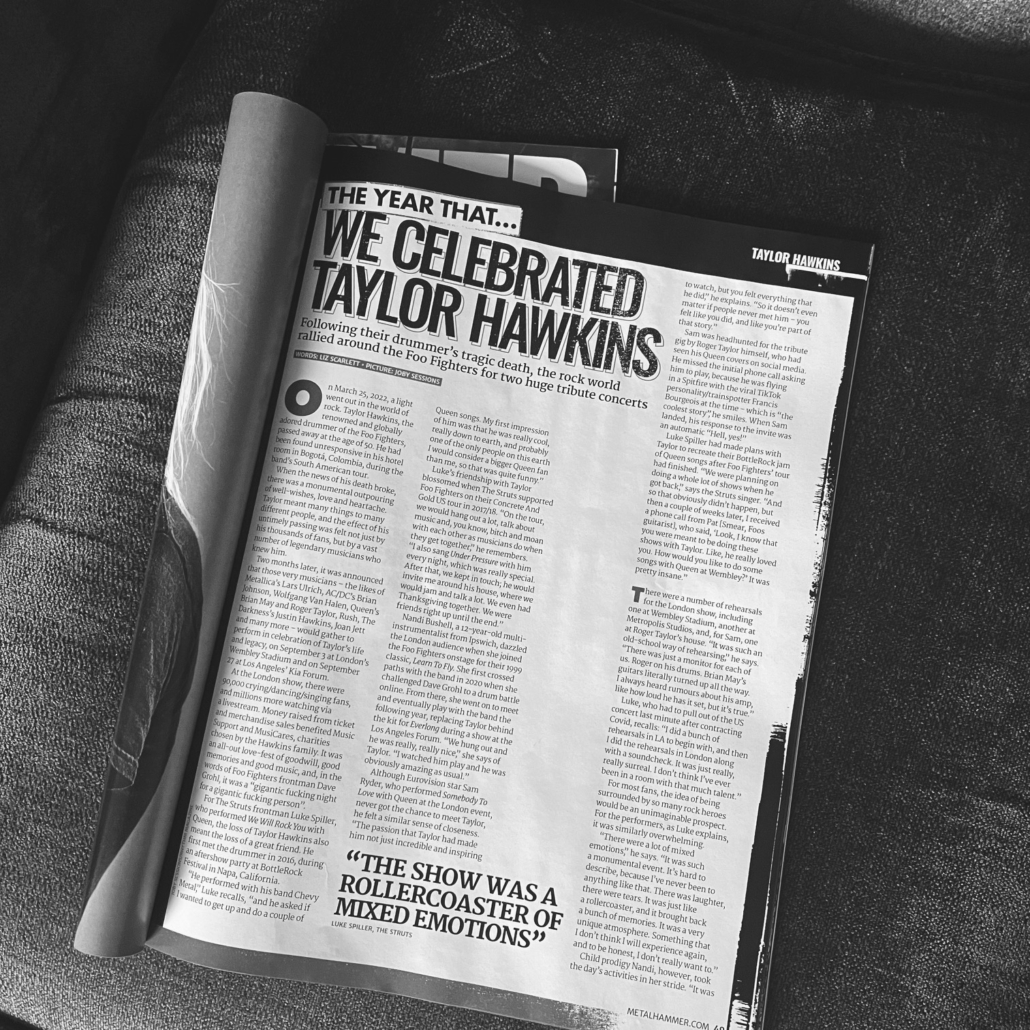
男性優位の業界に身を置く女性として、何か困難に直面したこと/ハラスメントを経験したこと/自分を証明するためにもっと努力する必要があると感じたこと/など、基本的に女性であることを理由にした問題はないのでしょうか? 入社当初はどのようにこの業界を体験されたのでしょうか?
今の仕事では、全くないですね。 私のチームは、このような問題を本当によく考えてくれていて、メガサポートをしてくれています。 しかし、以前の職場(名前は伏せますが)では、とても
そうそう 同じようなスキルを共有する場合、男性の同僚は本当に威圧的であることがわかりました。 私は、見下され、侮辱されたALOTで、感じた。
女性であることを理由に、参加したくなかった競技です。 ひどいときには、会社に来たくないということもありました。 すべてであった。
他の同僚に対して、男性に限って圧倒的に尊敬の念を抱いているのを見ると、もっとイライラする。 これは何度もあったことです。
今、私はどうなっているかというと、業界の男性に比べれば、自分の仕事に自信が持てないかもしれませんが、とてもサポートされていると感じています。 さらに、インポスター
症候群は常に迫っている。 また、自分のアイデアに自信が持てないこともあるので、そこは変えていかなければと思っています。 でも、女性として成長するための一部だと思います。
他のアイデア(男性からの提案)は、通常、常にあなたよりも真剣に受け止められてきたのに。 音楽と文章を書くことが好きなのは、もともと相通じるものがあったのでしょうか?
実はそうじゃなかったんです。 僕はベースを弾いて育ったので、僕にとって音楽は常に楽器的な側面が重要でした。 曲を聴いていても、脳が
は、歌詞や他の構成要素よりも、自然にリフに集中します。 文章を書くようになったのは、自分が音楽について話すのがどれだけ好きか気づいたときだと思います。
そして、自伝を読み、私にインスピレーションを与えてくれたミュージシャンの人生について学ぶことが、どれほど好きであるかを発見したのです。 近年では
また、私の音楽への思いは、作曲だけでなく、アートやデザインへのこだわりなど、さまざまな部分を包含しています。 音楽は、私のあらゆるところに入り込んでいます。
の生活を送ることができます。
音楽ジャーナリズムを語る上で、特に影響を受けた人はいますか?
を書くのですか? (推薦図書、著者、ジャーナリストなど、ご自由にどうぞ)
このようなことになると、私はいつも頭が真っ白になってしまうのですが、音楽ドキュメンタリーはいつも大きなインスピレーションを与えてくれました。 私のお気に入りは、Super
また、アメリカのアンダーグラウンドなハードロックシーンを描いた『Such Hawks, Such Hounds』や、『Duper Alice Cooper』(全体のビジュアルデザインも最高です。
を70年代から2000年代後半まで続けてきた。 また、サイケデリックなアートワークやアルバムジャケットにも注目です。 最近、ブレット・モーゲンの『Moonage Daydream』に度肝を抜かれました。 非常に多かったです。
アートと映像音楽ジャーナリズムの究極の融合のような、圧倒されそうなサウンドトラック。 他にもたくさんあると思いますが、これらは間違いなく、そのうちの一つです。
私のお気に入りをいくつか紹介します。 本に関しては、『スティーヴィー・ニックス』の著者であるゾエ・ハウがいます。Visions, Dreams and Rumours(ヴィジョンズ、ドリームズ、ルーモアズ)』は、大きなインスピレーションを与えてくれました。 その上、完全にクールな女性である。
自称ロックンロールの魔女であるハウの素晴らしい文体は、実に描写力があり、力強く、読むだけで楽しい。 彼女のどの本でも、あなたは
というのがすぐにわかる、そんな作家さんに憧れます。 すぐに彼らの作品だとわかるようなタイプ。
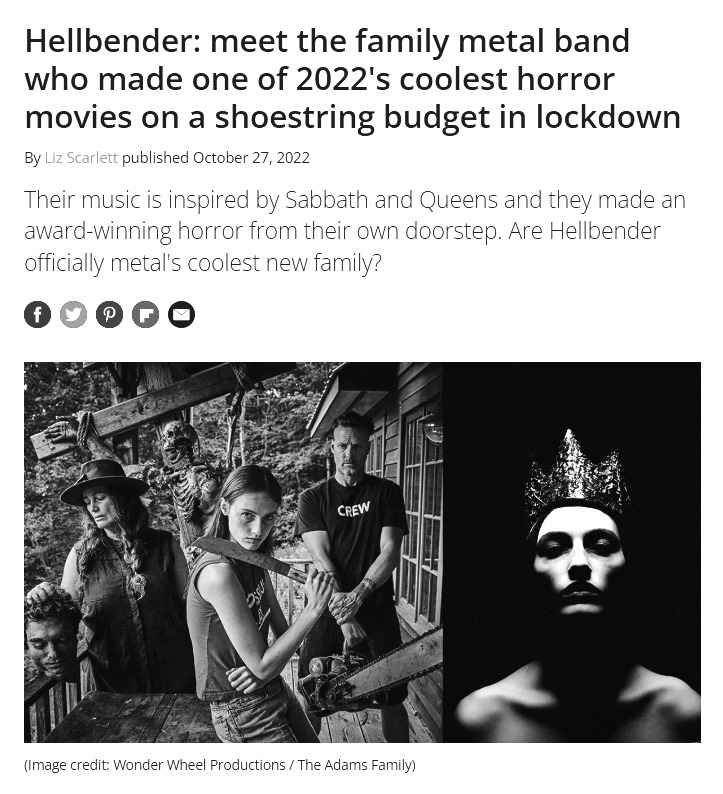
これまでのキャリアのハイライトは何だったのでしょうか?
本当に、毎日を好きなことをして、クリエイティブに過ごすことができるんです。 でも…トニー・アイオミとの出会いも、かなりクールでしたね。
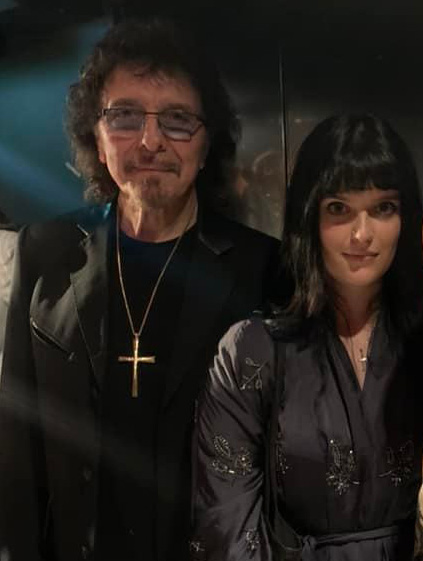
2023年のリズは、2013年のリズに何を言うのでしょうか?
もし男の子が変に見えたら、それは私たちが家父長制の中で生きているからで、何もかもがめちゃくちゃなんです。
あなたより優れている また、フリートウッド・マックのコンサートも見てください。いつかメンバーの何人かがここにいなくなり、手遅れになる日が来るでしょうから。 (もう手遅れですが)。
現在、リピート再生しているアーティスト/楽曲は?
現在、Sleep Tokenが手放せません。 フロントマンのボーカルに自信がない方は(ちょっとジェームス・アーサーっぽいですが)、ぜひコンサートを見てみてください。
を変換する。 彼らはモダンなメタルコアのルールブックを完全に破っており、そのリフはあなたを床に叩きつけるでしょう。 それに、見た目が不気味なのも良いですね。
リジーのInstagramをフォローするか、こちらのウェブサイトをご覧ください。

